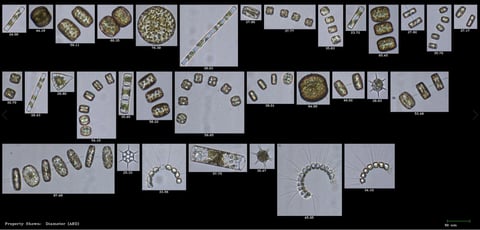Flow Imaging Microscopy is a fast and automated method to see highly-resolved digital images of microscopic particles in a flowing liquid. Using FlowCam, you can very quickly learn about the size, count, shape, and identity of the particles in your sample.
Flow Imaging Microscopy began as a novel concept when the first flow imaging microscope—FlowCam—was developed at Bigelow Laboratory for Ocean Sciences in Boothbay Harbor, Maine. The then-available tools, a microscope for plankton identification and a flow cytometer for counting, were time-consuming and labor-intensive, so the scientists at Bigelow sought to develop a better method.

Their FlowCam design combined the benefits of a flow cytometer and a microscope in a single instrument. A sample of ocean water could be introduced into the system, and particles would be automatically, digitally imaged and analyzed.
Today, FlowCam is an essential tool in particle characterization labs in a broad array of biologics and materials applications that care about the size, shape, and morphology of particles in solution:
- Aquatic: the study of microbial life in the world’s marine and freshwater bodies to understand key processes driving these ecosystems
- Biopharma: characterization of biopharmaceutical aggregates and other subvisible particles in parenteral drugs to evaluate the stability of formulations
- Cell and gene therapy: analysis of cells, aggregates of drug carriers, and drug delivery vehicles
- Food and beverage: quality control of food ingredients where particle shape can affect taste and texture
- Materials: formulation development, process troubleshooting, and QA/QC testing for microspheres, emulsions, encapsulated materials, fibers, and polymers.

How Does Flow Imaging Particle Analysis Work?
The flow imaging particle analysis workflow is streamlined with FlowCam! A sample containing particles is injected into a flow cell, where it flows through a path positioned between a light source and a magnifying objective in front of a digital camera. As the sample passes by, the camera automatically captures images of up to 50,000 particles per minute.
In real-time, VisualSpreadsheet software extracts single particle images from the camera images. It compiles a variety of basic measurements such as particle count, diameter, volume, and aspect ratio, as well as more advanced morphology measurements like circularity, elongation, and perimeter. Other particle characteristics include intensity, transparency, and color. Using VisualSpreadsheet, you can readily sort, filter, classify, and display your data analysis in various formats.
Direct Particle Measurements
One of the key advantages of flow imaging microscopy with FlowCam is that particle measurements are calculated directly from an image of the particle. Since flow imaging microscopy is designed with fixed optics at known magnifications, distance measurements on the image can be directly converted to real distance measurements on the object. Flow imaging systems do not have to make any assumptions about a particle’s size and shape because they measure multiple particle properties directly from an image.
Other particle analysis systems, such as light obscuration, laser diffraction, and light scattering, need to make assumptions about the particle's physical dimensions. These techniques measure a signal proportional to a physical dimension and convert that signal to a value representing the number of particles and corresponding particle size distribution in the sample. In addition, many of these analytical techniques only measure ensemble (bulk) properties, i.e., the properties of the overall population distribution.
The ultimate benefit of performing flow imaging microscopy with a FlowCam imaging system is that you can visualize single particles and calculate desired sample properties based directly on individual particle images.
Download our eBook on Flow Imaging Microscopy to learn more.
Would FlowCam work for me?
Send us a brief description of your application and we’ll be happy to discuss how FlowCam can help you accurately characterize your particles!
Click here to describe your application











